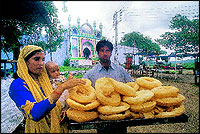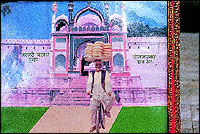


|
|
|
ABOUT 24 kilometres outside Aurangabad is Khuldabad, a simple town, said to be unpretentious about being the final resting place of Emperor Aurangzeb. Legend has it that Aurangzeb would have wanted it this way, perhaps, for this most feared Mughal emperor saved money for his tomb Rauza (Abode of Peace) through the sale of skullcaps that he stitched and copies of the Koran than he personally wrote. The English rulers later and the Hyderabadi nizams added to the simple structure and today it is almost like a place of pilgrimage with tourists travelling from Aurangabad just to visit Emperor Aurangzeb�s tomb and get a glimpse of history. Tiny shops outside the tomb sell blankets of roses called �chaddars� which the faithful drape over the emperor�s tomb. And there are other small businesses in the verdant and peaceful surroundings of Khuldabad that sell attars and gemstones that some visitors take back as souvenirs. But almost everybody stops at the Roza Durbar Khaja Centre just outside the steps leading to the tomb where one of Aurangabad�s most famous delicacies is made and sold. The Khaja is typical of Khuldabad. You must sample it if you are going there.
|

Home Page
About the mag
Subscribe
Advertise
Contact Us

 Selling Khajas Outside Aurangzeb�s Tomb!
Selling Khajas Outside Aurangzeb�s Tomb!
 The main business in the area is run by a handsome young Muslim couple, Taufiq Ahmed and Munawar Begum. They are in business at Khuldabad for the last 10 years and live in a village nearby. The Khaja is made by Taufiq and Munawar in a small shack behind their business stall. It is a large fluffy pastry, like a big bhatura or paratha, but heavier and flaky. The ingredients that go into the Khaja are maida, ghee, sugar, khoa, jeera, ajwain, and salt. A dough is made of the maida, khoa, sugar, jeera, ajwain and salt and this is deep-fried in a boiling cauldron of ghee to make a large Khaja. One piece costs Rs. 10 and it is money well spent. The young couple is ignorant about what the real association of Khaja with Khuldabad and Aurangzeb�s tomb is. �I am here because I come from a village nearby and because Khaja was always being sold outside the Rauza,� admits Taufiq. �Earlier, my father used to run the business. He used to make the Khaja at home and then stack it seven, eight-layers high on a tray which he would place on his head and cycle all the way to the tomb. His hands never left the handlebars to hold the tray! People used to see Dad cycling and make way for him.�
The main business in the area is run by a handsome young Muslim couple, Taufiq Ahmed and Munawar Begum. They are in business at Khuldabad for the last 10 years and live in a village nearby. The Khaja is made by Taufiq and Munawar in a small shack behind their business stall. It is a large fluffy pastry, like a big bhatura or paratha, but heavier and flaky. The ingredients that go into the Khaja are maida, ghee, sugar, khoa, jeera, ajwain, and salt. A dough is made of the maida, khoa, sugar, jeera, ajwain and salt and this is deep-fried in a boiling cauldron of ghee to make a large Khaja. One piece costs Rs. 10 and it is money well spent. The young couple is ignorant about what the real association of Khaja with Khuldabad and Aurangzeb�s tomb is. �I am here because I come from a village nearby and because Khaja was always being sold outside the Rauza,� admits Taufiq. �Earlier, my father used to run the business. He used to make the Khaja at home and then stack it seven, eight-layers high on a tray which he would place on his head and cycle all the way to the tomb. His hands never left the handlebars to hold the tray! People used to see Dad cycling and make way for him.�